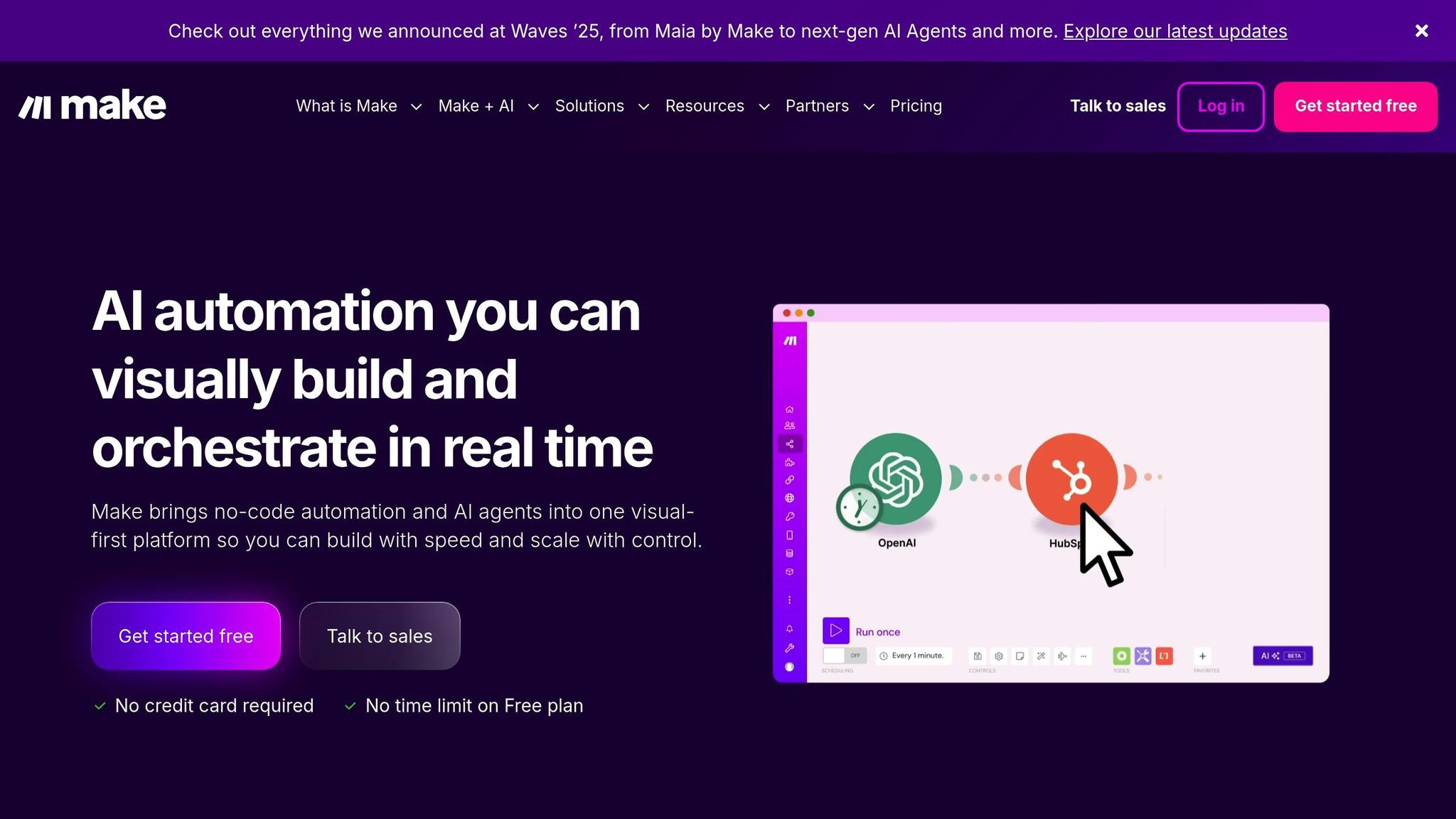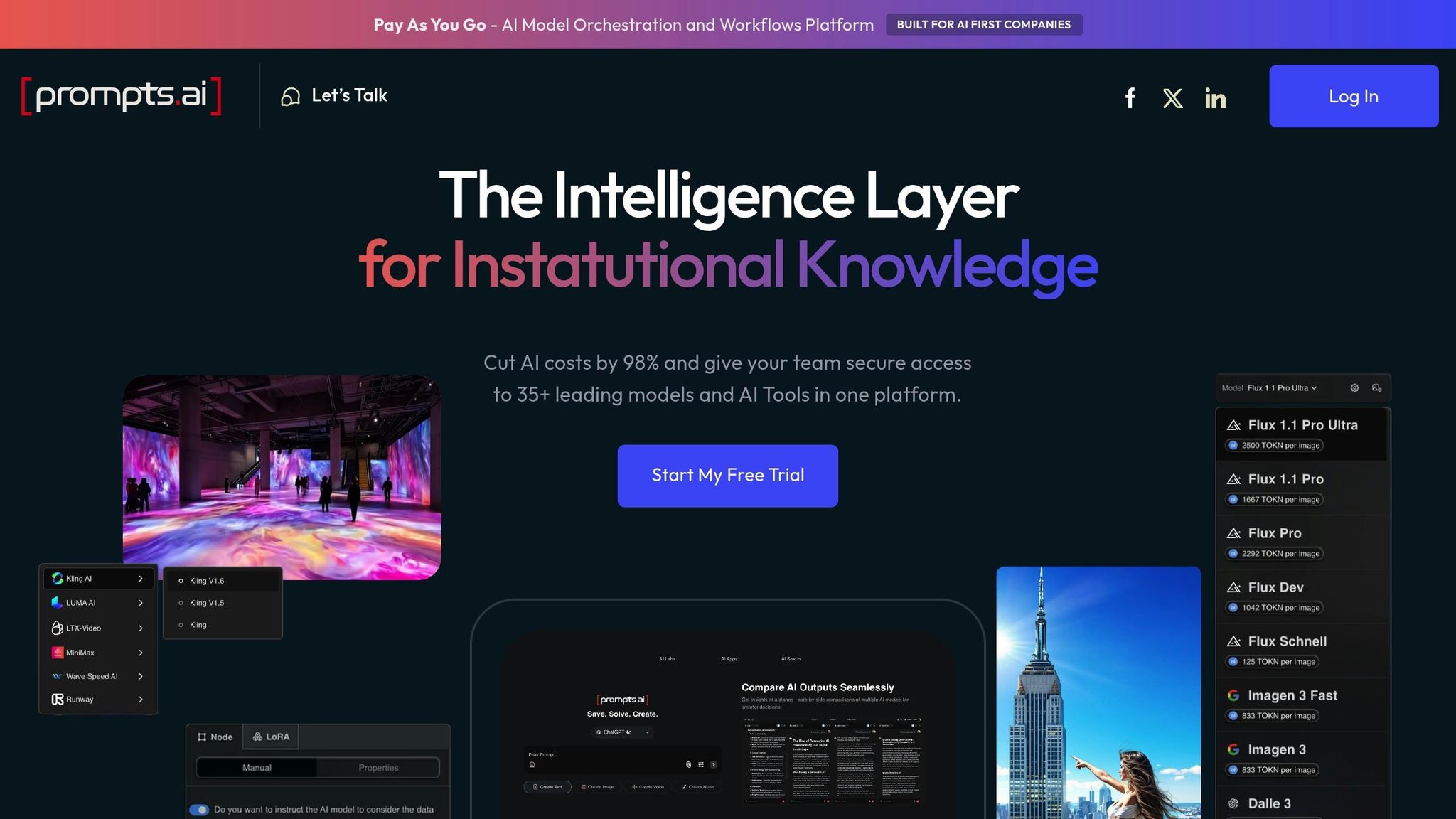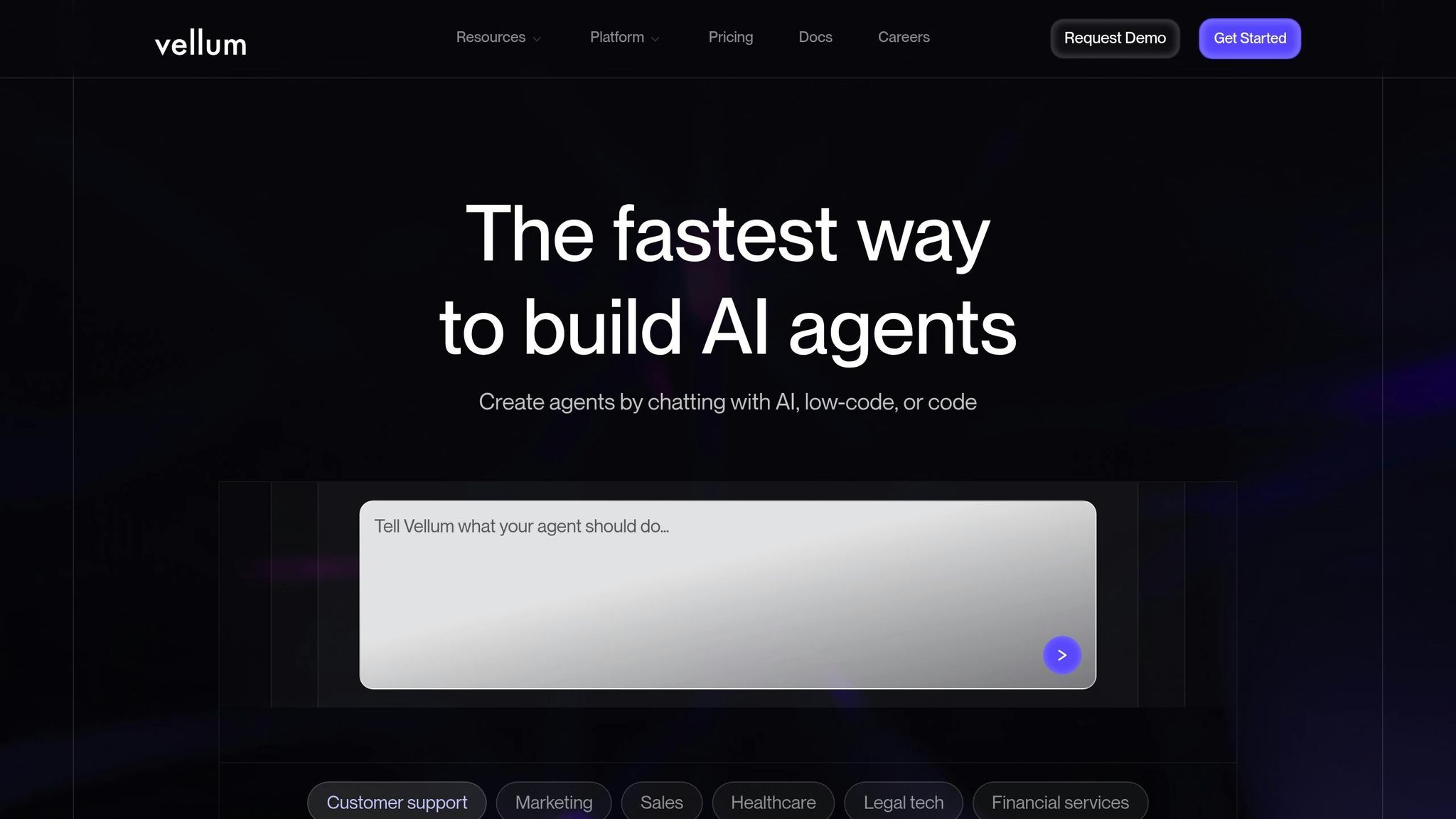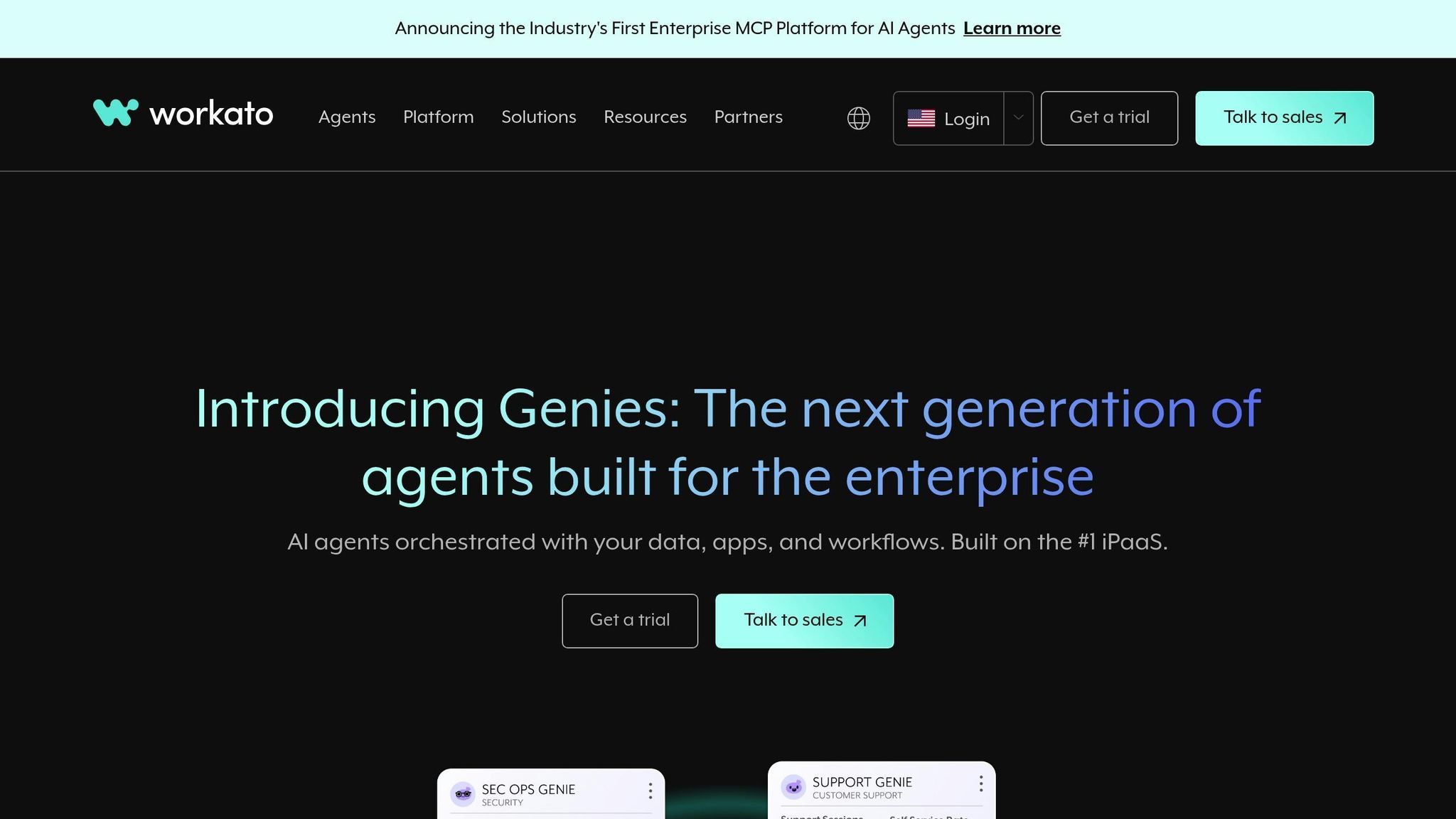
AI workflow automation is reshaping how businesses operate, saving time and cutting costs by automating repetitive tasks. Top platforms like Prompts.ai, Zapier, Make, Vellum AI, and Workato offer solutions for streamlining operations, improving efficiency, and integrating AI into daily workflows. Here's a quick breakdown:
Each tool caters to different needs, from small teams to enterprise-level operations. Below is a comparison to help you decide.
| Platform | Starting Price | Best For | Key Limitation |
|---|---|---|---|
| Prompts.ai | $0/month | AI orchestration, cost savings | Limited to AI-specific use cases |
| Zapier | $0/month | Simple automations, beginners | Struggles with complex workflows |
| Make | $10.59/month | Complex workflows | Steeper learning curve |
| Vellum AI | $25/month | Natural language workflows | Limited enterprise features |
| Workato | Enterprise pricing | Large-scale integrations | High cost, complex setup |
AI-enabled workflows are projected to grow from 3% to 25% of enterprise processes by the end of 2025, driving productivity and reducing errors. Choosing the right platform depends on your team's needs, budget, and technical expertise.


Prompts.ai stands out as a solution tailored for efficient AI workflow management and cost reduction. Designed to be the intelligence layer for institutional knowledge, this platform simplifies the management of multiple AI tools in enterprise settings. Founded by Emmy Award-winning Creative Director Steven P. Simmons, Prompts.ai provides access to over 35 top-tier AI models - including GPT-5, Claude, LLaMA, and Gemini - through a single, secure interface. This streamlined approach can reduce AI-related costs by up to 98%.
At the heart of Prompts.ai lies its unified AI orchestration, which allows teams to manage and compare major language models side by side using one dashboard. This eliminates tool sprawl and incorporates FinOps cost controls to keep expenses in check.
The platform prioritizes governance and security, meeting SOC 2 Type II, HIPAA, and GDPR compliance standards, with active monitoring powered by Vanta.
Its TOKN credit system replaces traditional subscription models, offering a pay-as-you-go pricing structure. This ensures organizations only pay for what they use while maintaining clear visibility into spending.
Additional tools include Image Studio Pro for creating photorealistic visuals, LoRA training and fine-tuning for custom AI model development, and workflow automation tools that handle complex, multi-step processes across departments. These features cater to a variety of professional needs, enabling impactful results.
Prompts.ai serves a wide range of industries and professionals:
With flexible pricing plans, Prompts.ai accommodates both individual users and enterprise teams.
Prompts.ai offers a range of pricing options to suit different needs:
Personal Plans
Business Plans
Prompts.ai integrates seamlessly with widely used business tools like Slack, Gmail, and Trello, enabling automated workflows across various platforms. For businesses with custom needs, the platform also supports API and webhook connections, allowing for tailored integrations into proprietary systems.
Prompts.ai excels in multi-model orchestration, enabling users to compare outputs from various large language models in a single interface. The platform includes built-in prompt engineering tools with features like version control and team collaboration, making it easier to refine prompts without disrupting workflows.
"With Prompts.ai's LoRAs and workflows, he now completes renders and proposals in a single day - no more waiting, no more stressing over hardware upgrades."
– Steven Simmons, CEO & Founder
Additionally, real-time performance analytics help teams evaluate model effectiveness for specific tasks, allowing for data-driven decisions on AI model selection and budget optimization.
Zapier links over 5,000 apps through event-triggered automations called Zaps, now enhanced with the power of generative AI. By combining workflow automation with AI, Zapier simplifies business operations and takes productivity to the next level. With the introduction of Zapier AI, the platform now integrates generative AI tools directly into its automation workflows, offering a blend of intuitive design and advanced AI functionalities.
One of Zapier's standout features is its visual builder interface, designed to be user-friendly - even for those without technical expertise. Zaps form the backbone of automation, enabling users to set up workflows that react to specific triggers and carry out predefined actions across connected apps.
Zapier Canvas, an AI-powered tool, helps users map out multi-step processes and collaborate on workflow design. Additional features like autoreplay and conditional paths within multi-step logic allow for more tailored automations, making it adaptable to a wide range of scenarios.
Zapier caters to various teams and industries with its versatile capabilities:
From basic tasks like adding new leads to a CRM to complex workflows involving email summarization and dynamic text generation, Zapier offers solutions for both simple and sophisticated needs.
Zapier provides a tiered pricing model to accommodate different team sizes and usage levels. A free plan supports basic automations, while paid tiers scale based on the number of tasks performed each month and offer access to advanced features. This flexible pricing ensures that businesses of all sizes can find a plan that fits their needs.
Zapier’s vast ecosystem connects more than 5,000 applications through prebuilt triggers and actions, enabling smooth data flow across various tools. Whether it’s productivity software, CRMs, marketing platforms, or project management tools, Zapier acts as a bridge, allowing businesses to unify their workflows and eliminate software silos.
Zapier integrates GPT-powered actions directly into its workflows. With Zapier AI Actions, businesses can seamlessly add intelligent steps - like summarization, translation, or data enrichment - into their processes. This allows teams to harness AI capabilities as an integral part of their broader automation strategies.
Make, previously known as Integromat, has evolved from a traditional automation platform into a tool that seamlessly incorporates AI into workflow automation. Known for its user-friendly visual interface, Make allows users to design complex workflows, referred to as "scenarios", with ease.
At the heart of Make is its visual editor, which offers a drag-and-drop interface that simplifies the creation of workflows. It supports advanced features like conditional logic and looping, allowing users to build detailed decision trees.
The platform also includes native support for API calls and webhooks, enabling seamless integration of AI services. For example, users can embed AI-powered actions - such as those from OpenAI or Google Cloud APIs - directly into their workflows. Additional features like scenario versioning and scheduling help teams manage multiple workflow iterations and control automation timing. Meanwhile, error handling tools, including execution history and logging, provide the transparency needed for troubleshooting. These capabilities make Make a versatile tool for a range of automation needs.
Make is a go-to platform for both non-technical users and technical teams looking to streamline operations. Operations managers and small business owners can use it to automate tasks across marketing, CRM, and support tools without needing advanced coding skills. On the other hand, startups and creative agencies often rely on Make to manage content creation and enrich data through external AI APIs. SaaS teams also benefit from its ability to prototype AI-driven internal tools quickly, minimizing the need for extensive engineering resources.
One of Make's standout features is its ability to connect a wide range of applications and services through its visual workflow builder. It integrates seamlessly with popular business tools like CRMs, marketing platforms, and project management software. For scenarios where a direct integration isn’t available, the platform’s API-first design lets users create custom connections using webhooks and HTTP requests. This flexibility ensures that users can design workflows tailored to their unique needs, including those leveraging large language models.
Although Make doesn’t offer native AI modules, it excels at integrating large language models via external APIs. Users can embed AI services like OpenAI or Google Cloud AI into their workflows to perform tasks such as text generation and data analysis. This approach gives businesses the freedom to select their preferred AI providers and switch between models as requirements evolve, ensuring adaptability and control over their automation strategies.

Vellum AI is a cutting-edge platform for automating workflows powered by large language models (LLMs). Established in 2023 with $25.5 million in funding, it takes a fresh approach to automation by using natural language prompts instead of traditional drag-and-drop tools. This makes it an ideal solution for businesses aiming to develop more advanced, AI-driven processes.
By combining prompt engineering, workflow orchestration, and collaboration tools into one workspace, Vellum AI enables users to move beyond basic task automation. Its focus on natural language prompts and team collaboration sets it apart, offering a streamlined way to create and manage sophisticated workflows.
Vellum AI’s Prompt Builder is a standout feature, allowing users to design, test, and refine prompts in real time. This tool supports chaining prompts, adding variables, and fine-tuning outputs - all without needing to write code. Users can also preview responses from various AI models, making it easier to choose the best fit for their needs.
The platform’s collaborative workspace bridges the gap between technical and non-technical teams. Developers and business users can work together to refine prompts, configure automation logic, and test AI agents before deployment. This ensures that the final implementation aligns with both technical specifications and business goals.
Vellum AI excels in creating custom AI agents and chatbots and automating multi-step workflows through natural language prompts. Businesses can design, test, and deploy AI solutions that seamlessly integrate with their existing systems.
Vellum AI offers a free plan for teams looking to explore basic AI agent development. For more advanced features, paid plans start at $25 per month.
With its API-first design, Vellum AI integrates effortlessly with existing business systems and third-party applications. It supports webhook and custom API connections, enabling businesses to embed AI-driven workflows directly into their software while maintaining high standards for security and compliance.
Built for dynamic, LLM-driven workflows, Vellum AI supports multiple large language models, giving users the flexibility to experiment and optimize based on factors like cost, speed, and accuracy. Its prompt versioning feature further enhances the iterative development of AI solutions, allowing teams to refine their workflows over time.

Workato stands out as a platform tailored for enterprise-level integration and automation, seamlessly incorporating AI into business workflows.
At its core, Workato uses "Recipes" to link business rules, AI-driven decisions, and cross-application actions into workflows that are both scalable and secure. This approach combines low-code tools, real-time data processing, and autonomous AI logic, making it a strong choice for organizations looking to integrate AI into their critical operations.
Workato simplifies complex integrations with its AI-powered data mapping, which automatically identifies and links data fields across various applications, cutting down on manual work. Its document processing capabilities handle tasks like extracting, analyzing, and routing data from different file types without requiring human input. The platform’s sentiment analysis tool categorizes and responds to customer communications based on emotional tone and context, enhancing customer interactions. Additionally, the human-in-the-loop feature ensures that critical decisions are reviewed when necessary, striking a balance between efficiency and oversight.
Enterprise teams use Workato to bring AI into essential processes such as automating customer service, monitoring compliance, and streamlining procurement workflows. Its focus on security and reliable AI-driven decision-making makes it particularly suitable for industries with stringent operational requirements. These applications are powered by Workato's Recipe-based framework, which ensures robust and efficient integration.
The Recipe-based framework is designed to support secure, scalable integrations, enabling smooth data flow between diverse systems. This architecture is built to meet the high demands of enterprise environments, ensuring reliability and security.
Workato’s platform also enables the integration of large language models (LLMs) into AI workflows. This allows businesses to process natural language inputs, make contextual decisions, and execute intricate processes. With AI-enabled workflows expected to grow from 3% to 25% of enterprise processes by 2025 - a striking eightfold increase - Workato is well-positioned to help organizations navigate this shift.
Each platform brings its own strengths and challenges, shaping how they impact operations and budgets. By understanding these differences, you can make decisions that align with your technical needs and use cases. Below, we’ve outlined the key benefits and limitations of each platform to help guide your choice.
Prompts.ai simplifies AI tool management by offering access to over 35 top language models through a single interface. Its pay-as-you-go TOKN credit system can slash AI software costs by up to 98%. Additionally, its enterprise-grade governance features and real-time FinOps controls ensure compliance and cost transparency. However, its AI-specific focus might feel less adaptable for organizations that prioritize traditional automation.
Zapier shines with its vast app ecosystem and user-friendly visual builder, making it ideal for non-technical users who need quick and simple automation. Its usage-based pricing offers predictable costs, especially for small to medium businesses. That said, it is best suited for straightforward, two-step automations and may struggle with more complex workflows requiring advanced logic.
Make (formerly Integromat) excels in creating visually complex workflows with advanced logic. Its credit-based pricing is appealing for handling intricate, conditional workflows. However, the platform has a steeper learning curve, and its credit-based pricing can become less predictable for high-volume users.
Workato is tailored for large-scale enterprise integrations that demand scalability and advanced functionality. However, its higher costs and complexity make it less suitable for smaller businesses with simpler needs.
Here’s a quick comparison of the platforms:
| Platform | Starting Price | Best For | Main Limitation |
|---|---|---|---|
| Prompts.ai | Pay‑as‑you‑go | AI orchestration & cost savings | Specialized AI focus |
| Zapier | $0/month | Simple automations & beginners | Limited complexity |
| Make | $10.59/month | Complex visual workflows | Steep learning curve |
| Workato | Enterprise pricing | Large-scale integrations | High cost & complexity |
The demand for scalable and cost-effective automation tools continues to grow. Companies leveraging AI automation report an average 20% productivity boost, while automated workflows can reduce errors by up to 90%.
When considering cost-effectiveness, remember that 60% of small and medium businesses favor usage-based pricing for its flexibility. However, hidden costs - like integration complexity, training, and ongoing maintenance - can significantly affect overall investment. Balancing specialized AI features with broader automation capabilities is crucial in today’s competitive landscape.
Ultimately, selecting the right platform depends on your technical expertise, scalability requirements, and budget. The right choice can maximize both productivity and cost efficiency.
The world of AI workflow automation is advancing at an incredible pace. By the end of 2025, AI-enabled workflows are projected to jump from just 3% to 25% of all enterprise processes. This dramatic increase highlights the growing acknowledgment of generative AI’s potential to contribute $2.6 to $4.4 trillion in annual economic value. With stakes this high, selecting the right platform has never been more crucial.
Each platform brings something different to the table, catering to varied business needs. Prompts.ai stands out for its robust AI orchestration capabilities and cost-saving features, coupled with enterprise-grade governance to ensure secure AI deployment. For businesses that prioritize simplicity and integration with a wide range of apps, Zapier remains a popular choice. Make, on the other hand, is ideal for teams requiring advanced logic and visually complex workflows, while Workato is tailored for organizations with large-scale integration demands.
The emergence of AI-native platforms is reshaping the industry landscape. Unlike older automation tools, these platforms are built with AI at their core, enabling advanced capabilities like complex AI agents and sophisticated orchestration. It’s no surprise that CFOs are now allocating 25% of their AI budgets to AI agents.
When choosing a platform, it’s essential to assess your team’s technical expertise. Platforms with user-friendly, intuitive interfaces are better suited for non-technical teams, while those offering Python SDKs and customization options appeal to developers. Governance should also be a top priority, as 78% of organizations now use AI in at least one business function. Features like security, compliance, and audit trails are no longer optional - they’re mandatory.
The rise of low-code/no-code tools is further transforming the market. According to Gartner, 70% of new enterprise apps will be built using low-code or no-code platforms by 2025. This shift makes AI tools more accessible, favoring platforms with strong visual builders and easy-to-navigate interfaces. Ultimately, selecting the right platform means balancing immediate automation needs with a forward-looking AI strategy that can adapt to your organization’s evolving requirements.
The TOKN credit system is the backbone of payments on Prompts.ai, offering a versatile way to access a wide range of AI-driven tools and services. With TOKN credits, you can create text, images, videos, audio, and even music - all within a unified platform.
This pay-as-you-go approach puts you in charge of your spending. Instead of juggling multiple subscriptions, you can manage all your AI needs under one streamlined credit system. It’s a simple way to save both time and money while keeping your workflow efficient and hassle-free.
Prompts.ai prioritizes top-tier security and compliance standards to keep your data safe. By aligning with frameworks such as SOC 2 Type II, HIPAA, and GDPR, the platform ensures strong protections and adherence to key regulatory requirements.
To uphold these standards, Prompts.ai employs continuous monitoring via Vanta, maintaining tight control over data security. On June 19, 2025, the platform began its SOC 2 Type II audit process, reinforcing its dedication to enterprise-level compliance and reliability.
Prompts.ai has found its way into a variety of industries, helping businesses simplify processes and boost productivity. Companies have leveraged it to automate tasks in areas like sales, marketing, and operations, freeing up time and cutting down on resource use.
In the creative world, an Emmy-winning director harnessed Prompts.ai to tackle intricate projects - like renders and proposals - in just a single day. Likewise, an architectural visualization expert sped up the production of photorealistic visuals, and an acclaimed visual AI director used it to prototype and refine concepts with improved efficiency.
Whether it’s architects shaping bold designs or professionals automating content creation and strategic workflows, Prompts.ai has enabled users to accomplish more in less time, opening doors to greater creativity and streamlined operations.


